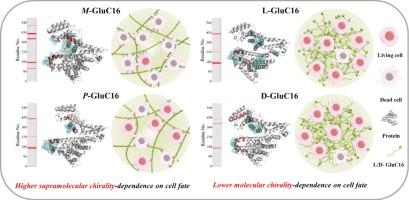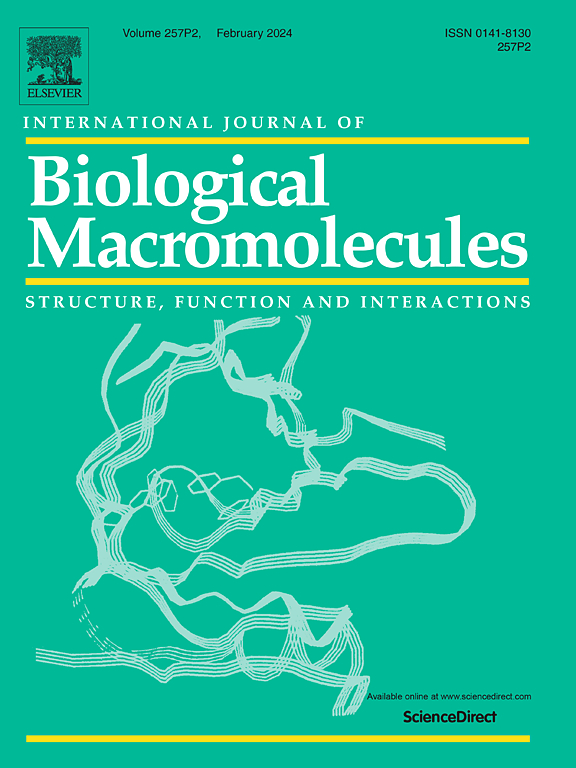超分子手性对纳米蛋白质/细胞相互作用的影响:实验与计算研究
IF 7.7
1区 化学
Q1 BIOCHEMISTRY & MOLECULAR BIOLOGY
International Journal of Biological Macromolecules
Pub Date : 2024-12-01
DOI:10.1016/j.ijbiomac.2024.137613
引用次数: 0
摘要
与分子手性相比,了解超分子手性在纳米-蛋白质/细胞相互作用中的独特作用对于阐明生命起源至关重要。然而,这一方面却没有得到足够的重视。本研究合成了具有分子手性的基于 L/D 谷氨酸的双亲化合物(L/D-GluC16)。此外,通过操纵溶剂效应,由 L/D-GluC16 组装出了具有超分子手性的左/右手螺旋纳米纤维(M/P-GluC16)。借助分子动力学(MD)模拟,研究了 M/P-GluC16、L/D-GluC16 和模型蛋白质(牛血清白蛋白,BSA)之间在热力学和空间取向水平上的相互作用。结合蛋白质吸附效率的实验结果,证实与 L/D-GluC16 相比,M/P-GluC16 与蛋白质的结合更依赖于手性。此外,与 L/D-GluC16 相比,M/P-GluC16 在结合诱导的构象变化和随后的蛋白质功能破坏的驱动下,表现出更大的手性特异性癌细胞抑制功效,突出了超分子手性对纳米-蛋白质/细胞相互作用的影响比分子手性更为显著。本文章由计算机程序翻译,如有差异,请以英文原文为准。

Effect of supramolecular chirality on nano-protein/cell interaction: An experimental and computational investigation
Understanding the unique role of supramolecular chirality in nano-protein/cell interactions, as opposed to molecular chirality, is crucial for elucidating the origin of life. However, this aspect has received inadequate attention. In this study, L/D-glutamic acid-based amphiphiles (L/D-GluC16), which possess molecular chirality, were synthesized. Additionally, through the manipulation of solvent effects, left/right-handed helical nanofibers (M/P-GluC16), endowed with supramolecular chirality, were assembled from L/D-GluC16. With the aid of molecular dynamics (MD) simulations, the interaction between M/P-GluC16, L/D-GluC16, and a model protein (bovine serum albumin, BSA) was investigated at the thermodynamic and spatial orientational levels. Combined with the experimental result of protein adsorption efficiency, a more favorable chirality-dependent binding of M/P-GluC16 to protein compared to L/D-GluC16 was confirmed. Furthermore, driven by the binding-induced conformational changes and subsequent functional disruptions of proteins, M/P-GluC16 exhibited a greater chirality-specific cancer cell inhibitory efficacy compared to L/D-GluC16, highlighting the more significant impact of supramolecular chirality on nano-protein/cell interactions than molecular chirality.
求助全文
通过发布文献求助,成功后即可免费获取论文全文。
去求助
来源期刊
CiteScore
13.70
自引率
9.80%
发文量
2728
审稿时长
64 days
期刊介绍:
The International Journal of Biological Macromolecules is a well-established international journal dedicated to research on the chemical and biological aspects of natural macromolecules. Focusing on proteins, macromolecular carbohydrates, glycoproteins, proteoglycans, lignins, biological poly-acids, and nucleic acids, the journal presents the latest findings in molecular structure, properties, biological activities, interactions, modifications, and functional properties. Papers must offer new and novel insights, encompassing related model systems, structural conformational studies, theoretical developments, and analytical techniques. Each paper is required to primarily focus on at least one named biological macromolecule, reflected in the title, abstract, and text.

 求助内容:
求助内容: 应助结果提醒方式:
应助结果提醒方式:


